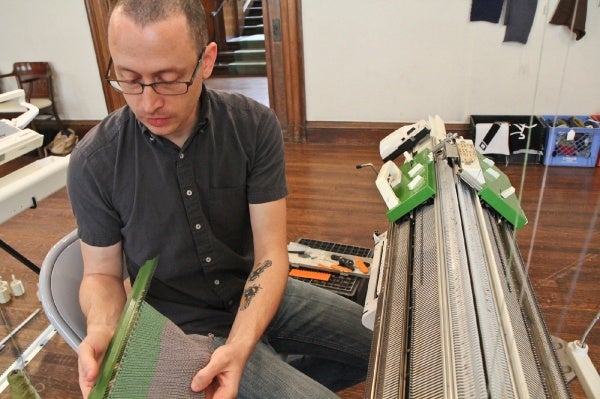Knit lab explores surprising future of ancient craft
Renita Sollie wandered into the ground-floor gallery of the Philadelphia Art Alliance with two of her kids, ages 6 and 4. She occasionally knits things for them by hand.
“My girls like the socks that I make,” said Sollie. “My son calls them sweater-socks and he refuses to wear them.”
Sollie’s son, Stanley, has an attitude similar to that of Andrew Dahlgren. The industrial designer finds most American knitwear boring. He does not knit by hand, but is fascinated by knitting machines.
This week Dahlgren is in residence at the Art Alliance in Rittenhouse Square, where he has set up three automated knitting machines in the gallery space.
Dahlgren recently returned from Germany where he attended an intensive eight-week course of operating highly sophisticated knitting equipment at Stoll, a manufacturer pushing the possibilities of textiles.
The machines set up in the Art Alliance were made 30 and 40 years ago, for the domestic market. They can knit about 60 rows minute, but they have not come into style with knitting’s current popularity.
Dalgren learned to knit a simple hand stitch a few years ago, and says he didn’t care much for it. These machines that occupy the middle ground between hand-craft and industrial-scale knitting offer him the opportunity to experiment with patterns and shapes.
“This is the future,” said Dahlgren, showing off a tiny white knit T-shirt, fit for a doll. “It came off the machine completely finished. It’s a whole sweater, basically. There’s no secondary process. It comes off the machine completed knitted and ready to wear.”
Most sweaters are knitted in three pieces — the torso and two sleeves — that are then sewn together. But some computer-operated machines can knit in three dimensions, turning out an entire object with one continuous thread. Imagine a sweater with no seams.
The possibilities go beyond clothing. Dalgren is trying to apply knitting concepts to architecture.
“People are doing high-tech knitting, where they will knit with a material to make tubes, and heat-treat it to make it a rigid structure,” said Dahlgren. “If you can imagine a shape that has multiple connectors, that has a combination of rigid and flexible, that can be done with knitting.”
Dalgren will welcome visitors at the Philadelphia Art Alliance every day this week.
WHYY is your source for fact-based, in-depth journalism and information. As a nonprofit organization, we rely on financial support from readers like you. Please give today.








